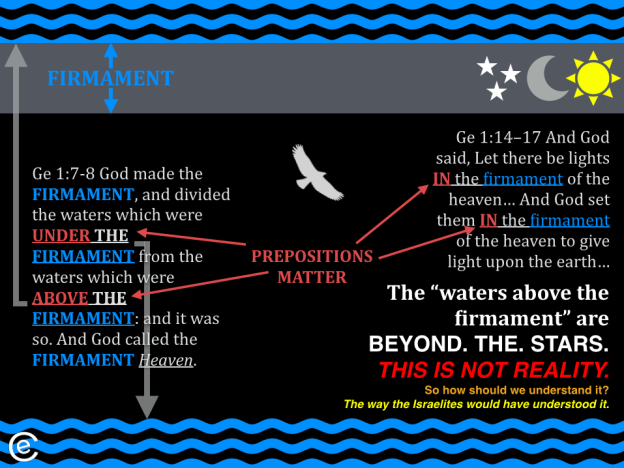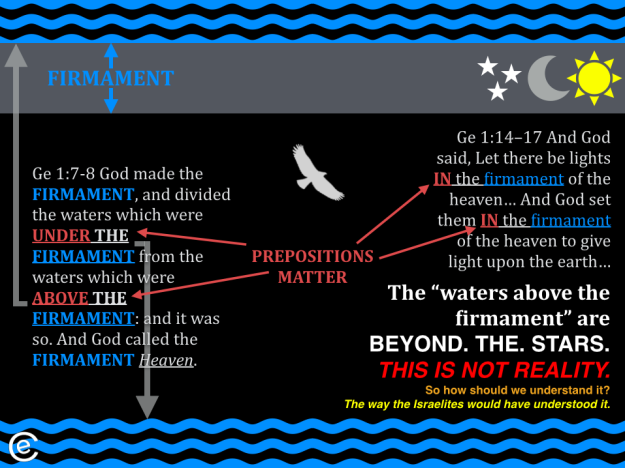The solid dome of Genesis 1 was THE reading of Gen 1 until the age of Galileo. But then things had to change. Now literalists try hard to read Genesis 1 in any way which avoids the obvious. A detailed review undermines the effort – but more eloquently so did a duck. Birds categorically fly underneath the clouds according to literalists but even ducks dislike their solutions. Continue reading
Category Archives: Firmament/Raqia
The Raqia: A Rejoinder to Allfree & Davies
A recent paper by Mark Allfree and Matt Davies (Is the Firmament of Genesis Chapter 1 Solid?, 2015) maintains that the firmament of Genesis 1 is not described as a solid dome but rather as an empty expanse. The authors also reject any suggestion that the creation account of Genesis 1 is written as a theological polemic against pagan creation myths. Their primary concern is the historicity of Genesis 1 and its consistency with a modern worldview. This article contends that Allfree and Davies begin with a false premise and arrive at the wrong conclusion via a series of misguided arguments. Continue reading
My Encounter with the Firmament – TheTorah.com
A fascinating Jewish perspective, reviewing the history of Jewish interpretation of the firmament. From the article:
The Torah describes God’s fashioning the firmament (רקיע) on the second day of creation. This piece of the universe, however, doesn’t actually exist—a problem obfuscated in my yeshiva education…Every pre-Copernican commentator in Judaism who wrote about the rakia knew exactly what it was.[8] The Talmud, for instance, records varying opinions about the thickness of what is clearly a solid firmament; from the seven layer firmaments of Resh Lakish (b. Chagigah 12b), to the two firmaments of R Judah (ibid.), from the finger-width firmament of Rav Joshua ben R Nehemia (Gen. Rab. 4:5), to the “50 year journey” firmament of Rav Judah (j. Berachot 2c).
Seeley on the Firmament
STANDARD Hebrew lexica and a number of modern biblical scholars have defined the raqiac (fyqr, “firmament”) of Gen 1:6-8 as a solid dome over the earth.1 Conservative scholars from Calvin on down to the present, however, have defined it as an atmospheric expanse.2 Some conservatives have taken special pains to reject the concept of a solid dome on the basis that the Bible also refers to the heavens as a tent or curtain and that refer- ences to windows and pillars of heaven are obviously poetic.3 The word raqiac, they say, simply means “expanse.” They say the understanding of raqiac as a solid firmament rests on the Vulgate’s translation, firmamentum; and that translation rests in turn on the LXX’s translation stere<wma, which simply reflected the Greek view of the heavens at the time the trans- lators did their work.4 The raqiac defined as an atmospheric expanse is the historical view according to modern conservatives; and the modern view of the raqiac as a solid dome is simply the result of forcing biblical poetic language into agreement with a concept found in the Babylonian epic
Enuma Elish.5
The historical evidence, however, which we will set forth in concrete detail, shows that the raqiac was originally conceived of as being solid and not a merely atmospheric expanse. The grammatical evidence from the OT, which we shall examine later, reflects and confirms this conception Continue reading
Wilfred Lambert stated the human race is more than 7,000 years old
Bro Wilfred Lambert was one of the foremost Assyriologists of his generation. He wrote quite explicitly about the connection between ancient near eastern ideas (about which he was an expert) and the impossibility of reconciling Gen 1-3 with science. Some of his specific observations in the following article are:
- The antiquity of the earth and man is unquestionably longer than biblical literalists can allow
- Gen 1 and Gen 2-3 are separate events and cannot be read as literal/scientific accounts
- The solid raqia was a common/borrowed understanding of the sky
- Humanity is far older than 7,000 years
Bro Wilfred was not disfellowshipped for such ideas (for the record – I take elements of Gen 2-3 more literally than he did) Continue reading
The Firmament and the Anchor Yale Dictionary
While ancient and conservative scholars have come to the same conclusion, below is an extensive entry on the Heaven as a physical reality in the Anchor Yale Bible Dictionary.
“In the Hebrew Bible “heaven” is sometimes used as a synonym for “firmament” (Heb rāqı̂aʿ) to describe the dome-shaped covering over the earth that separated the heavenly waters above from the earthly waters beneath (Gen 1:6–8; Ps 148:4). Heaven, or the firmament, was thought to be supported by pillars (Job 26:11) and had foundations (2 Sam 22:8) and windows. When the windows of heaven were opened, the waters above the firmament fell upon the earth as rain (Gen 7:11; 8:2; Isa 24:18). Through these windows God also poured out blessings upon the earth (Mal 3:10). The birds fly across the firmament (Gen 1:20; Deut 4:17) and the sun, moon, and stars were set in the firmament (Gen 1:14–18). Continue reading

Genesis 1:6 and the Firmament

One of the challenges in reading Genesis 1 as a literal account of exactly what God did is the firmament. The subject raises intense debate because many modern and (seemingly all) ancient scholars believe the Hebrew indicates a solid dome rather than an expanse (or sky). This creates enormous trouble for the literalist and passionate comments as a result. However the original readers had no such trouble. Continue reading
